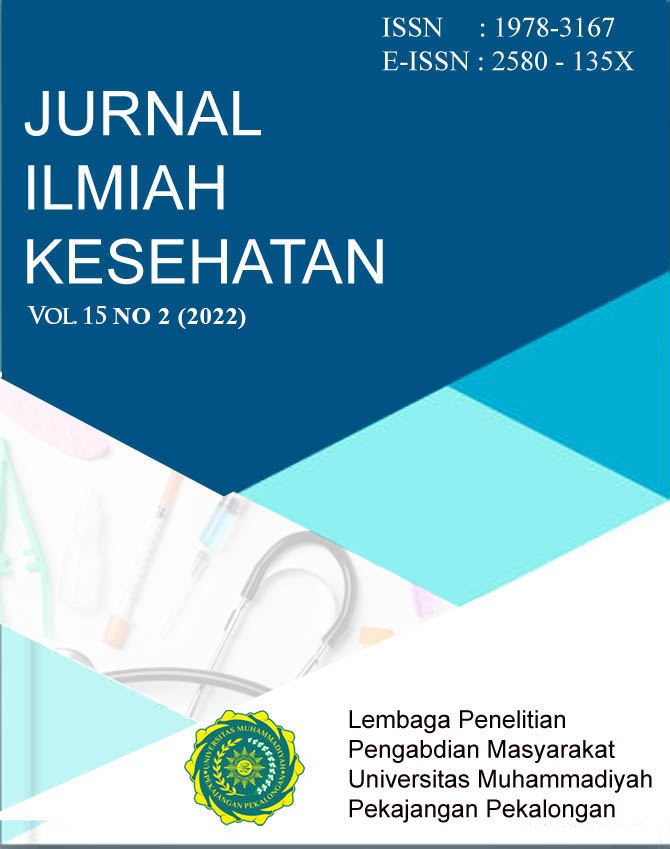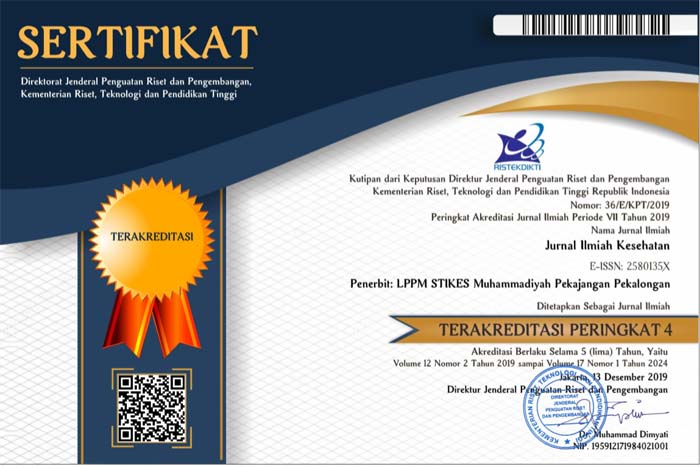Pelatihan MPKP untuk Meningkatkan Pengetahuan Perawat tentang MPKP di RSJ Grhasia Yogyakarta
DOI:
https://doi.org/10.48144/jiks.v15i2.1142Keywords:
Knowledge, MPKP TrainingAbstract
The professional nursing practice model (MPKP) is one of the efforts to improve the quality of nursing services. Knowledge is one of the important factors to support the optimal implementation of MPKP. The purpose of this study was to increase nurses' knowledge about MPKP and the implementation of MPKP in Grhasia Hospital through MPKP training. This research is a quantitative research with a pre-experimental design. The approach used is one group pretest and posttest design. Respondents in this study were all 37 Grhasia Hospital nurses who attended MPKP training. the average knowledge of nurses about MPKP before the training was 71.62, then after the MPKP training the average knowledge of nurses became 128.11. The results of the normality test showed that there was an abnormal distribution of the data so that the bivariate analysis used the Wilcoxon test. Based on the results of the Wilcoxon test, a p-value of 0.000 was obtained, so it can be concluded that MPKP training can increase nurses' knowledge about MPKP. Researchers consider it necessary to do further research on the implementation of MPKP in Grhasia Hospital Yogyakarta.
References
Peraturan Pemerintah Republik Indonesia Nomor 47 Tahun 2021 Tentang Penyelengaraan Bidang Perumahsakitan. .
I. S. Pohan, Jaminan Mutu Layanan Kesehatan. Jakarta: EGC, 2012.
N. Hoffart and C. Q. Woods, “Elements of a nursing professional practice model,” J. Prof. Nurs., vol. 12, no. 6, pp. 354–364, 1996, doi: 10.1016/S8755-7223(96)80083-4.
S. Slatyer, L. L. Coventry, D. Twigg, and S. Davis, “Professional practice models for nursing: A review of the literature and synthesis of key components,” J. Nurs. Manag., vol. 24, no. 2, pp. 139–150, 2016, doi: 10.1111/jonm.12309.
Setiadi, Manajemen dan Kepemimpinan dalam Keperawatan : teori dan aplikasi praktik bagi mahasiswa & perawat klinis. Yogyakarta: Indomedia Pustaka, 2016.
N. K. Sari, T. S. Prihatiningsih, and L. Lusmilasari, “Key elements of professional nursing practice: A scoping review,” Open Access Maced. J. Med. Sci., vol. 9, no. T4, pp. 253–260, 2021, doi: 10.3889/oamjms.2021.5885.
R. Sitorus, “Dampak Implementasi Model Praktik Keperawatan Profesional Terhadap Mutu,” J. Keperawatan Indones., vol. 7, no. 6, pp. 41–47, 2003.
P. P. Rahayu, B. A. Keliat, and Y. S. E. Putri, “Correlation Between Nurse Unit Manager and Team Leader Capability in Implementing Pnpm With Nursing Care Outcomes of Patient With Hallucination,” J. Keperawatan, vol. 5, no. 1, pp. 1–9, 2017.
S. Notoatmodjo, Ilmu Perilaku Kesehatan. Jakarta: Rineka Cipta, 2016.
Setiawati, L. Rohayani, and I. Akmaludin, “Hubungan Pengetahuan Perawat Pelaksana dengan Penerapan Model Asuhan Keperawatan Profesional di Ruang Penyakit Dalam dan Bedah RSUD Cibabat Kota …,” J. Kesehat. Kartika, vol. 14, no. 3, 2019.
Peraturan Gubernur Daerah Istimewa Yogyakarta Nomor 78 Tahun 2015. .
Sugiyono, Metode Penelitian Kuantitatif, Kualitatif dan R&D. Bandung: Alfabeta, 2016.
S. Notoatmodjo, Metodologi Penelitian Kesehatan. Jakarta: Rineka Cipta, 2018.
H. Bidjuni and S. Rompas, “Pengaruh Manajemen Model Asuhan Keperawatan Profesional Tim Terhadap Kualitas Pelayanan Keperawatan Di Bangsal Pria Rsud Datoe Binangkang Kabupaten Bolaang Mongondow,” J. Keperawatan UNSRAT, vol. 5, no. 2, p. 105437, 2017.
R. Basol, A. Hilleren-Listerud, and L. Chmielewski, “Developing, implementing, and evaluating a professional practice model,” J. Nurs. Adm., vol. 45, no. 1, pp. 43–49, 2015, doi: 10.1097/NNA.0000000000000153.
F. Kartikasari, A. Yani, and Y. Azidin, “Pengaruh Pelatihan Pengkajian Komprehensif Terhadap Pengetahuan Dan Keterampilan Perawat Mengkaji Kebutuhan Klien Di Puskesmas,” J. Keperawatan Suaka Insa., vol. 5, no. 1, pp. 79–89, 2020, doi: 10.51143/jksi.v5i1.204.
N. Suherlin, “Efektifitas Pelatihan Manajemen Bundle Care Healthcare Associated Infections ( Hais ) Terhadap Pengetahuan Perawat di RSI Siti Rahmah Padang,” Menara Ilmu, vol. 14, no. 2, pp. 61–69, 2020.
A. C. Meidianta and Milkhatun, “Hubungan antara Pelatihan Proses Keperawatan dengan Pengetahuan Perawat tentang Penerapan Standar Diagnosis Keperawatan Indonesia di RSUD Samarinda,” Borneo Student Res., vol. 1, no. 2, pp. 647–651, 2020.
G. Dessler, Manajemen Sumber Daya Manusia. Jakarta: Salemba Empat, 2015.
B. J. Mattia, M. E. Kleba, and M. L. do Prado, “Nursing training and professional practice: an integrative review of literature,” Rev. Bras. Enferm., vol. 71, no. 4, pp. 2039–2049, 2018, doi: 10.1590/0034-7167-2016-0504.
R. Webb, “Addressing The Global Health Workforce Crisis : Challenges For France, Germany, Italy, , SPAIN AND THE UKWorkforce Crisis: Challenges for France, Germany, Italy, Spain and the UK,” 2011.
K. Garzonis, E. Mann, A. Wyrzykowska, and P. Kanellakis, “Improving patient outcomes: Effectively training healthcare staff in psychological practice skills: A mixed systematic literature review,” Eur. J. Psychol., vol. 11, no. 3, pp. 535–556, 2015, doi: 10.5964/ejop.v11i3.923.
M. Hasibuan, Manajemen Sumber Daya Manusia. Jakarta: Bumi Aksara, 2019.
M. Aliyu, “Effect of Demonstration Method of Teaching on the Academic Performance of Students in Motor Vehicle Mechanic in Yobe State,” Int. J. Innov. Sci. Eng. Technol. Res., vol. 8, no. 2, pp. 59–65, 2020.
T. A. Umoru and B. Haruna, “Effect Of Demonstration And Lecture Methods On Academic Performance Of Senior Secondary School Students ’ In Biology , Maiduguri Metropolis , Borno State , Nigeria,” Niger. J. Bus. Educ., vol. 5, no. 2, pp. 49–54, 2018.
K. Giridharan and R. Raju, “Impact of Teaching Strategies: Demonstration and Lecture Strategies and Impact of Teacher Effect on Academic Achievement in Engineering Education,” Int. J. Educ. Sci., vol. 14, no. 3, pp. 174–186, 2016, doi: 10.1080/09751122.2016.11890491.
A. Basheer, M. Hugerat, N. Kortam, and A. Hofstein, “The effectiveness of teachers’ use of demonstrations for enhancing students' understanding of and attitudes to learning the oxidation-reduction concept,” Eurasia J. Math. Sci. Technol. Educ., vol. 13, no. 3, pp. 555–570, 2017, doi: 10.12973/eurasia.2017.00632a.
C. . Ochogba, C. . Ogide, and C. . Ogide, “Effect of Demonstration Method on Students ’ Academic Performance in Basic Technology in Secondary Schools in Ogba / Egbema / Ndoni Local Government Area , Rivers,” Int. J. Innov. Sci. Eng. Technol. Res., vol. 7, no. 2, pp. 28–32, 2019.
M. Lupupa, “The Impact of Demonstration Learning on Pupils Understanding of Preparation of Salts,” J. Educ. Pract., vol. 11, no. 3, pp. 114–117, 2020, doi: 10.7176/jep/11-3-13.
P. L. McNiel and K. M. Elertson, “Advocacy and awareness: Integrating LGBTQ health education into the prelicensure curriculum,” J. Nurs. Educ., vol. 57, no. 5, pp. 312–314, 2018, doi: 10.3928/01484834-20180420-12.
E. C. Negri, A. Mazzo, J. C. A. Martins, G. A. Pereira Junior, R. G. dos S. Almeida, and C. E. Pedersoli, “Clinical simulation with dramatization: gains perceived by students and health professionals,” Rev. Lat. Am. Enfermagem, vol. 25, 2017, doi: 10.1590/1518-8345.1807.2916.
A. E. Cortés-Rodríguez, P. Roman, M. M. López-Rodríguez, I. M. Fernández-Medina, C. Fernández-Sola, and J. M. Hernández-Padilla, “Role-Play versus Standardised Patient Simulation for Teaching Interprofessional Communication in Care of the Elderly for Nursing Students,” Healthcare, vol. 10, no. 46, 2022.
P. A. Hegland, H. Aarlie, H. Strømme, and G. Jamtvedt, “Simulation-based training for nurses: Systematic review and meta-analysis,” Nurse Educ. Today, vol. 54, no. April, pp. 6–20, 2017, doi: 10.1016/j.nedt.2017.04.004.












